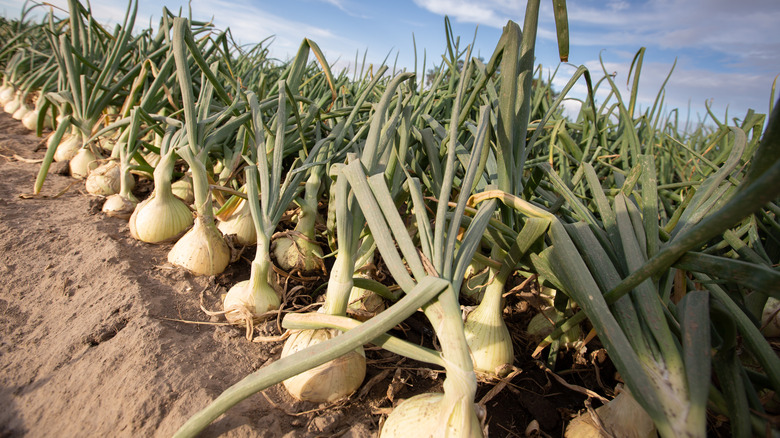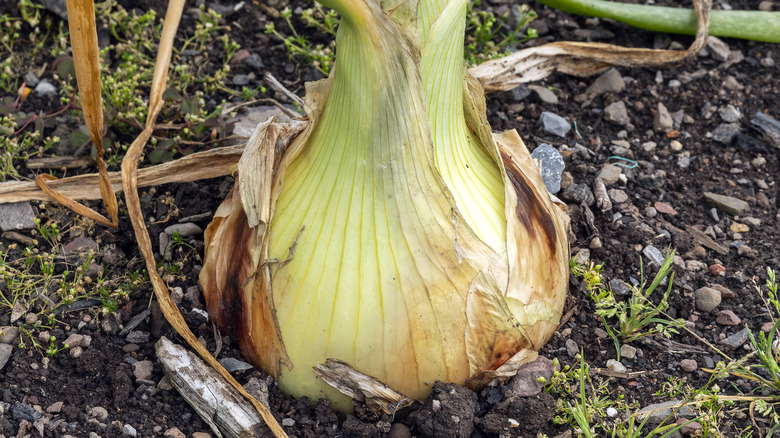The Sweet And Fast-Growing Onion Variety Martha Stewart Loves To Grow In Her Garden
Spring is here, which means it's finally time to bring your gardening gloves back out from their winter hibernation. In a "throwback Thursday" video clip posted to her TikTok account, Martha Stewart shared some timeless spring gardening tips, and revealed why she loves planting one specific type of sweet onion during this time of the year – the Walla Walla.
Known for its sweetness that many claim makes the onion as easy to bite into raw as an apple, the Walla Walla is fast-growing and easy to cultivate, making it a favorite among gardeners. However, as sought after as it is for its sweet, mild flavor, a genuine Walla Walla Sweet Onion is actually not easy to come by unless you live in a certain part of the country.
In 1995, the federal government ruled that in order for a sweet onion to be marketed as a true Walla Walla Sweet Onion, it must have been grown in the specified regions of either Walla Walla County, Washington, or Umatilla County, Oregon, while also meeting certain quality specifications (per The Spokesman-Review). Technically speaking, if the same sweet onion seed were planted outside of these regions, it wouldn't qualify as being a true Walla Walla Sweet Onion due to the difference in the soil outside of the federally-defined area.
What are Walla Walla Sweet Onions?
Allium cepa, or Walla Walla, is one of the only sweet onion varieties that belong to the Amaryllidaceae family while still remaining non-hybridized (per Specialty Produce.) Yellow to light brown in color, their papery exterior hides a firm, juicy center that provides them with the mild, sweet flavor that makes them popular to enjoy both raw and in all types of cooking.
"The variables of soil and climate come together to make the onions extra sweet and produce a wonderful crunch," says Sarah McClure, a federally certified grower through the Washington Department of Agriculture (per Seattle Times). That region-specific sweetness is due to the area's low sulfur content in the soil. "More sulfur in the soil means there's more acid," explains Michael Locati, a Washington farmer whose family has been growing Walla Walla onions for four generations. "This low-sulfur soil and the climate around the region make it so that we can have a sweet onion."
True Walla Walla Sweets have a very high water content, which makes them more sugary than other onion varieties, adding to their famous sweetness. The high water content, however, also makes for a short shelf life, making access to them even more limited (per The Spokesman-Review).
How are Walla Wallas grown in the garden?
Whether you are growing a genuine Walla Walla Sweet Onion or are planting a seed or seedling outside of the specified region, seeds are typically planted in September. They will grow in the spring, producing onions beginning in June and through July. To extend the growing season and availability of the onions, most farmers instead plant transplanted seedlings in the spring, allowing them to sell their produce for longer, often well into August (per the Spokesman-Review). In the video shared to TikTok, Martha Stewart planted her Walla Walla seedlings in April, noting that she initially began cultivating them in an indoor greenhouse in February before placing them in a furrow in her garden about an inch and a half deep and four inches wide.
The tips of the onions should be left uncovered when burying the roots with soil. Walla Walla grows best in full sun and should be watered at least once a week, making them an otherwise low-maintenance crop to grow in your garden. Once the onion sets are replanted into the ground, you can expect sweet onions in roughly 125 days. According to Michael Locati, Walla Walla are ready to harvest when their tall green stalks begin to bend (per The Spokesman-Review).
How to grow a sweeter sweet onion
While farmers and regional natives assert that it's not possible to grow an onion from seed or seedling outside of the Walla Walla Valley and have it be of the exact taste of a genuine Walla Walla Sweet Onion, it's possible to alter the pH levels of your soil to give your sweet onions an even sweeter taste. Because the Walla Walla Sweet Onion's famed sweetness is caused by the low acidity of the soil in the region, raising the pH levels of the soil in your garden can result in a sweeter-tasting onion.
If you have particularly acidic soil, adding ground agricultural limestone can help lower the acidity levels. While the amount of limestone your garden calls for depends on the clay content of your soil, the general rule is to apply 40 pounds of it for every thousand square feet of soil if you want to raise the pH by a single digit. However, introducing too much lime to your soil too quickly can raise its pH levels too much, potentially causing long-term damage to your soil that is hard to correct. So instead, apply the recommended amount, then do a soil test the following year to assess its acidity and determine if you need to add more limestone. According to Clemson University's College of Agriculture, do your soil test the following fall, applying limestone two to three months before planting in case you determine you need to add more.


